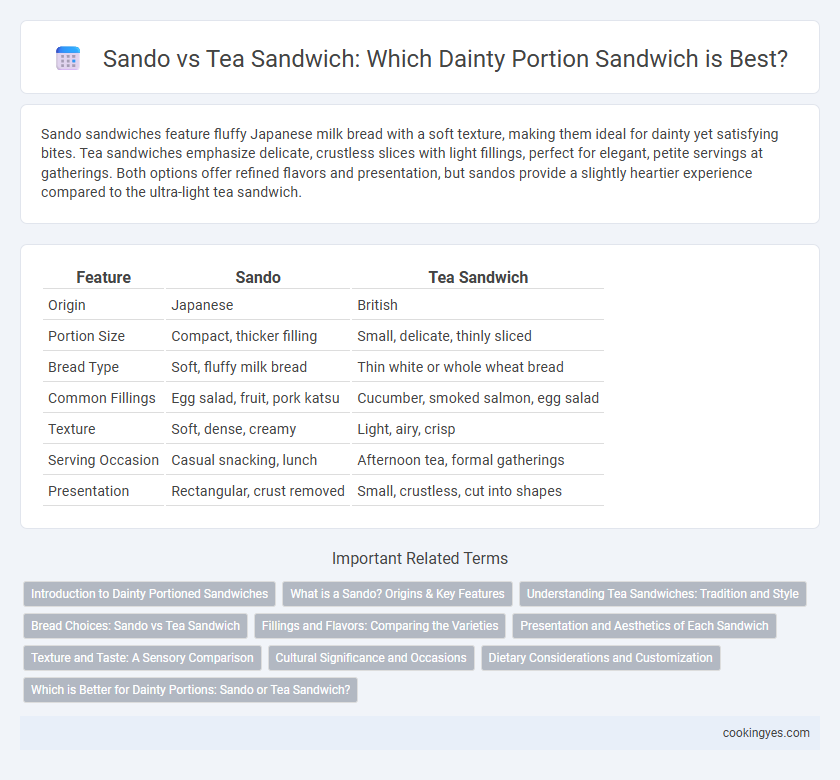Sando sandwiches feature fluffy Japanese milk bread with a soft texture, making them ideal for dainty yet satisfying bites. Tea sandwiches emphasize delicate, crustless slices with light fillings, perfect for elegant, petite servings at gatherings. Both options offer refined flavors and presentation, but sandos provide a slightly heartier experience compared to the ultra-light tea sandwich.
Table of Comparison
| Feature | Sando | Tea Sandwich |
|---|---|---|
| Origin | Japanese | British |
| Portion Size | Compact, thicker filling | Small, delicate, thinly sliced |
| Bread Type | Soft, fluffy milk bread | Thin white or whole wheat bread |
| Common Fillings | Egg salad, fruit, pork katsu | Cucumber, smoked salmon, egg salad |
| Texture | Soft, dense, creamy | Light, airy, crisp |
| Serving Occasion | Casual snacking, lunch | Afternoon tea, formal gatherings |
| Presentation | Rectangular, crust removed | Small, crustless, cut into shapes |
Introduction to Dainty Portioned Sandwiches
Dainty portioned sandwiches like Sando and tea sandwiches offer elegant, bite-sized options perfect for gatherings and afternoon teas. Sando, originating from Japan, features soft, crustless white bread filled with savory or sweet ingredients, emphasizing simplicity and texture. Tea sandwiches, traditional in British culture, are typically thin, crustless slices with delicate fillings such as cucumber or smoked salmon, crafted to complement tea service with refined presentation.
What is a Sando? Origins & Key Features
A Sando is a Japanese-style sandwich known for its soft, fluffy white bread, typically made from shokupan, and simple, fresh fillings like egg salad, tonkatsu, or fruit with cream. Originating from Japan post-World War II, Sandos emphasize clean flavors and neat presentation, making them a popular choice for dainty, portion-controlled servings. Unlike traditional Western tea sandwiches, Sandos highlight a delicate texture with minimal crust, offering a unique blend of Western sandwich concepts infused with Japanese culinary aesthetics.
Understanding Tea Sandwiches: Tradition and Style
Tea sandwiches, traditionally small and elegantly prepared, are designed for dainty portions often served during afternoon tea. Characterized by thinly sliced bread, delicate fillings like cucumber, smoked salmon, or egg salad, and crustless edges, they emphasize a refined presentation. Unlike larger, more casual sando sandwiches popular in Japanese cuisine, tea sandwiches prioritize subtle flavors and a sophisticated style that complements formal tea settings.
Bread Choices: Sando vs Tea Sandwich
Sando sandwiches typically use thick, soft Japanese milk bread called shokupan, which offers a slightly sweet and fluffy texture ideal for hearty fillings. Tea sandwiches favor thinly sliced white or whole wheat bread, often crustless and lightly buttered, enhancing the dainty presentation and delicate bite. Both bread choices complement their respective sandwich styles by balancing texture with portion size, making each perfect for their intended serving experience.
Fillings and Flavors: Comparing the Varieties
Sando sandwiches typically feature bold, Japanese-inspired fillings like tonkatsu, egg salad, and tamago, offering a harmonious balance of savory and sweet flavors in soft, fluffy bread. Tea sandwiches emphasize delicate, refined fillings such as cucumber with cream cheese, smoked salmon with dill, and egg with watercress, highlighting subtle, fresh flavors ideal for elegant occasions. Both varieties prioritize texture and flavor harmony, but Sandwiches lean toward hearty, flavorful bites while Tea sandwiches focus on light, refined taste profiles.
Presentation and Aesthetics of Each Sandwich
Sando sandwiches showcase a minimalist Japanese aesthetic with clean lines and neat, compact layers, enhancing their visual appeal as dainty, bite-sized portions. Tea sandwiches emphasize intricate patterns and delicate garnishes, often featuring ornate crusts and finely sliced ingredients that elevate table presentation. Both sandwiches excel in elegance, with Sando favoring simplicity and precision, while tea sandwiches highlight decorative flair and refined detail.
Texture and Taste: A Sensory Comparison
Sando offers a soft, pillowy texture with rich, savory fillings that deliver a satisfying bite, while tea sandwiches provide a delicate, airy crumb typically paired with light, refreshing ingredients for subtle flavor profiles. The buttery crust of tea sandwiches contrasts with the crustless, fluffy bread used in sandos, enhancing the dainty experience. Both prioritize balance in taste and texture, making them ideal for refined palates seeking either robustness or elegance in portioned sandwiches.
Cultural Significance and Occasions
Sando, originating from Japan, features soft white bread and precise fills, symbolizing modern Japanese culinary artistry and commonly served in casual settings or bento boxes. Tea sandwiches, rooted in British tradition, use crustless, thinly sliced bread with delicate fillings, embodying elegance and refinement typically reserved for afternoon tea and formal gatherings. Both styles reflect their cultures' social rituals, with Sando emphasizing simplicity and convenience, while tea sandwiches highlight sophistication and ceremony.
Dietary Considerations and Customization
Sando offers a versatile base for dietary customization, accommodating gluten-free bread and low-carb fillings, ideal for health-conscious consumers. Tea sandwiches, traditionally smaller and crustless, cater to those seeking low-calorie, portion-controlled options suitable for vegan or allergy-sensitive diets. Both formats allow for ingredient flexibility, enabling tailored choices like plant-based spreads or nutrient-dense proteins to meet specific dietary needs.
Which is Better for Dainty Portions: Sando or Tea Sandwich?
Sando sandwiches, known for their fluffy Japanese milk bread and creamy fillings, offer a soft texture and rich flavor ideal for dainty portions, making them perfect for delicate presentation. Tea sandwiches traditionally feature thinly sliced bread with light, savory fillings like cucumber or smoked salmon, emphasizing elegance and subtle taste profiles ideal for refined gatherings. Choosing between Sando and tea sandwiches depends on the desired texture and flavor intensity, with Sando providing a more substantial bite and tea sandwiches focusing on lightness and refinement.
Sando vs Tea Sandwich for dainty portioned sandwiches Infographic

 cookingyes.com
cookingyes.com